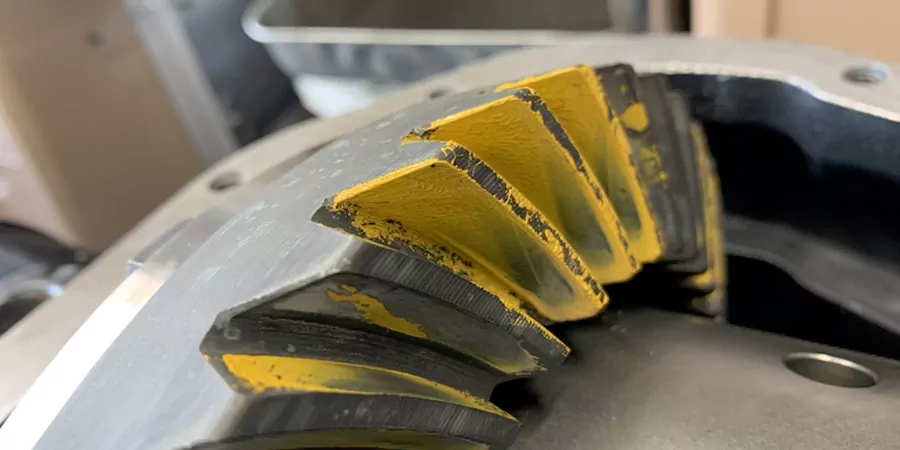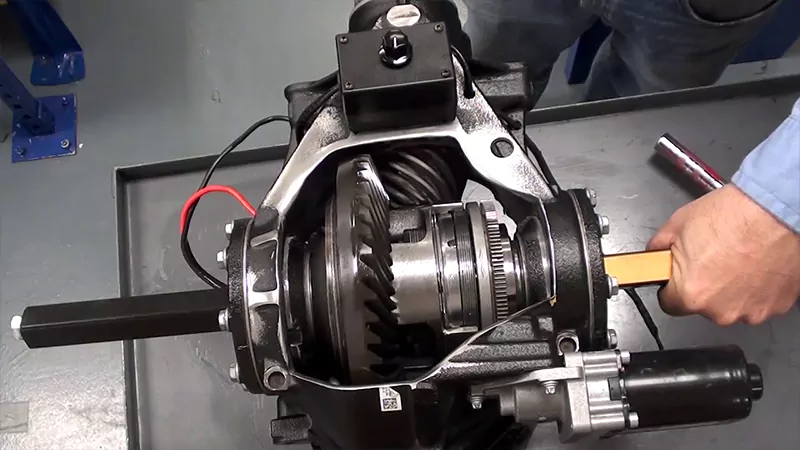The Crown Wheel and Pinion, known as the differential ring gear and pinion, is divided into the pinion gear and the ring gear.

Working Principle
The differential consists of a driving pinion gear (also known as the pinion) and a driven ring gear. The driving pinion gear is connected to the transmission shaft and rotates clockwise. The driven ring gear meshes with the driving pinion gear and rotates downward, in the direction of the wheel’s forward movement. Due to the smaller diameter of the driving pinion gear and the larger diameter of the driven ring gear, the differential achieves its function of reducing speed.

The Speed Ratio of Crown Wheel and Pinion
The speed ratio of a crown wheel and pinion is a fundamental aspect of a vehicle’s differential gearing system. It is determined by the number of teeth on the crown wheel (the larger gear) and the pinion (the smaller gear).
The speed ratio is calculated by dividing the number of teeth on the crown wheel by the number of teeth on the pinion. For example, if the crown wheel has 41 teeth and the pinion has 10 teeth, the speed ratio would be 41/10 = 4.10. This means that for every one rotation of the crown wheel, the pinion must rotate 4.10 times.
The speed ratio has a direct impact on the mechanical advantage of the differential. A higher speed ratio (i.e., a larger number for the ratio) provides greater torque multiplication, which can improve the vehicle’s ability to accelerate and climb gradients. However, a higher speed ratio also results in lower top speed and potentially higher fuel consumption, as the engine will be operating at higher RPMs for a given vehicle speed.
Conversely, a lower speed ratio (i.e., a smaller number for the ratio) provides less torque multiplication but allows for higher top speeds and potentially better fuel efficiency.
Automotive engineers carefully select the speed ratio of the crown wheel and pinion to achieve a balance between torque, speed, and fuel efficiency based on the intended use of the vehicle.
Automotive engineers carefully select the speed ratio of the crown wheel and pinion to achieve a balance between torque, speed, and fuel efficiency based on the intended use of the vehicle.
Manufacturing Process of a Crown Wheel and Pinion
The manufacturing process of a crown wheel and pinion involves several steps to ensure precision and durability:
- Material Selection: High-quality steel, such as alloy steel, is typically used for crown wheels and pinions due to its strength and wear resistance.
- Cutting the Blanks: The crown wheel and pinion start as cylindrical blanks. The crown wheel blank is turned on a lathe to create the basic shape, while the pinion blank is shaped using a hobbing machine or milling cutter.
- Heat Treatment: Both the crown wheel and pinion undergo heat treatment processes to enhance their hardness and durability. This usually involves heating the parts to a specific temperature and then rapidly cooling them.
- Machining the Teeth: The teeth of the crown wheel and pinion are machined using gear-cutting machines. The crown wheel’s teeth are cut into the outer edge of the gear, while the pinion’s teeth are cut into the smaller gear’s circumference.
- Grinding: After machining, the teeth are ground to achieve precise dimensions and smooth surfaces, ensuring proper meshing and minimal noise during operation.
- Quality Control: Each crown wheel and pinion undergo rigorous quality control checks to ensure they meet the required specifications for tooth profile, pitch, and surface finish.
- Testing: The finished crown wheel and pinion are tested for proper meshing, noise levels, and durability to ensure they meet performance standards.

The rough machining of gears plays a crucial role in the entire gear manufacturing process. The reference surfaces used for gear surface machining and inspection must be machined during the rough machining stage of gear blanks. At the same time, the machining of gear blanks accounts for a large proportion of the total processing time, which has a significant impact on production efficiency and gear machining quality. Excessive allowance will lead to an increase in the amount of semi-finish and finish machining required, increasing processing time and reducing production efficiency. If the allowance is too small, special care must be taken in subsequent machining, otherwise the gear’s design accuracy dimensions may be exceeded, resulting in a non-conforming product.
Conclusion
Crown wheel and pinion, are typically replaced when they show signs of wear or damage. Common reasons for replacement include noise (such as whining or grinding sounds), vibration, or abnormal play in the differential. Regular maintenance and inspection can help identify issues early and prevent more severe damage to the differential.



